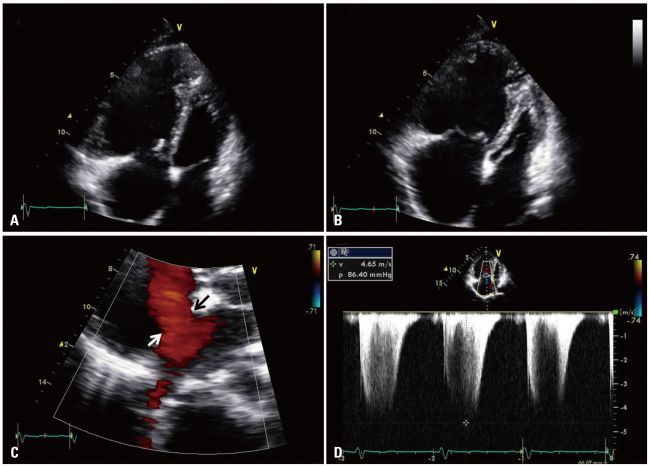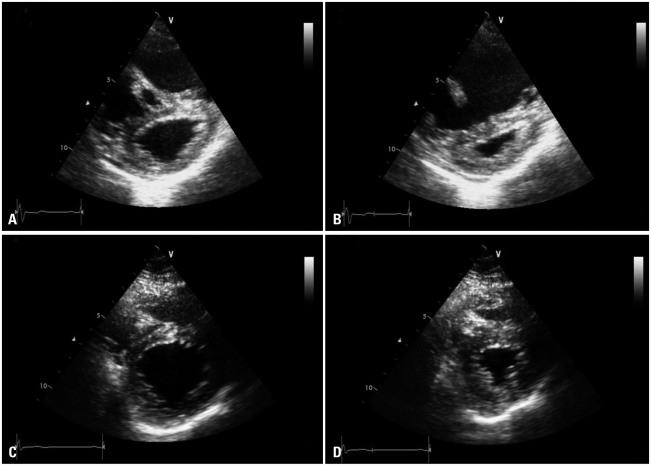J Cardiovasc Ultrasound.
2011 Sep;19(3):159-162. 10.4250/jcu.2011.19.3.159.
Transient Use of Oral Bosentan Can Be an Additional Option to Reduce Pulmonary Arterial Hypertension in a Patient with Severe Pulmonary Arterial Hypertension Associated with Atrial Septal Defect
- Affiliations
-
- 1Cardiology Division of Internal Medicine, School of Medicine, Chungnam National University, Chungnam National University Hospital, Daejeon, Korea. jaehpark@cnuh.co.kr
- 2Department of Cardiovascular Surgery, School of Medicine, Chungnam National University, Chungnam National University Hospital, Daejeon, Korea.
- KMID: 1980373
- DOI: http://doi.org/10.4250/jcu.2011.19.3.159
Abstract
- Atrial septal defect (ASD) with severe pulmonary arterial hypertension (PAH) is thought to preclude shunt closure. However, there are several reports that vasodilator treatment is associated with good clinical outcome in these patients, recently. We report a case of good clinical outcome in a patient with ASD and severe PAH successfully treated with operative closure of ASD and subsequent use of oral bosentan medication. This case supports that the corrective repair of ASD and an oral bosentan treatment can be one of the treatment options in the selected patients with severe PAH associated with ASD.
MeSH Terms
Figure
Cited by 1 articles
-
Device Closure of a Large Atrial Septal Defect in a Patient with Severe Pulmonary Arterial Hypertension after 1 Year Use of an Oral Endothelin Receptor Antagonist
In Hyun Jung, Sang Yun Lee, Sook Jin Lee, Joo Young Lee, Nam Jin Park, Dea Sung Ahn, Jae Hoon Jung, Dong Hee Shin, Dal Soo Lim
J Cardiovasc Ultrasound. 2013;21(3):140-144. doi: 10.4250/jcu.2013.21.3.140.
Reference
-
1. Steele PM, Fuster V, Cohen M, Ritter DG, McGoon DC. Isolated atrial septal defect with pulmonary vascular obstructive disease--long-term follow-up and prediction of outcome after surgical correction. Circulation. 1987; 76:1037–1042. PMID: 3664992.2. Murphy JG, Gersh BJ, McGoon MD, Mair DD, Porter CJ, Ilstrup DM, McGoon DC, Puga FJ, Kirklin JW, Danielson GK. Long-term outcome after surgical repair of isolated atrial septal defect. Follow-up at 27 to 32 years. N Engl J Med. 1990; 323:1645–1650. PMID: 2233961.3. Kim YH, Yu JJ, Yun TJ, Lee Y, Kim YB, Choi HS, Jhang WK, Shin HJ, Park JJ, Seo DM, Ko JK, Park IS. Repair of atrial septal defect with Eisenmenger syndrome after long-term sildenafil therapy. Ann Thorac Surg. 2010; 89:1629–1630. PMID: 20417794.4. Schwerzmann M, Zafar M, McLaughlin PR, Chamberlain DW, Webb G, Granton J. Atrial septal defect closure in a patient with "irreversible" pulmonary hypertensive arteriopathy. Int J Cardiol. 2006; 110:104–107. PMID: 15992947.5. Sachweh JS, Daebritz SH, Hermanns B, Fausten B, Jockenhoevel S, Handt S, Messmer BJ. Hypertensive pulmonary vascular disease in adults with secundum or sinus venosus atrial septal defect. Ann Thorac Surg. 2006; 81:207–213. PMID: 16368366.6. Cherian G, Uthaman CB, Durairaj M, Sukumar IP, Krishnaswami S, Jairaj PS, John S, Krishnaswami H, Bhaktaviziam A. Pulmonary hypertension in isolated secundum atrial septal defect: high frequency in young patients. Am Heart J. 1983; 105:952–957. PMID: 6858843.7. Craig RJ, Selzer A. Natural history and prognosis of atrial septal defect. Circulation. 1968; 37:805–815. PMID: 5646864.8. Balint OH, Samman A, Haberer K, Tobe L, McLaughlin P, Siu SC, Horlick E, Granton J, Silversides CK. Outcomes in patients with pulmonary hypertension undergoing percutaneous atrial septal defect closure. Heart. 2008; 94:1189–1193. PMID: 17932093.9. Yamauchi H, Yamaki S, Fujii M, Iwaki H, Tanaka S. Reduction in recalcitrant pulmonary hypertension after operation for atrial septal defect. Ann Thorac Surg. 2001; 72:905–906. discussion 906-7. PMID: 11565678.10. Galiè N, Beghetti M, Gatzoulis MA, Granton J, Berger RM, Lauer A, Chiossi E, Landzberg M. Bosentan Randomized Trial of Endothelin Antagonist Therapy-5 (BREATHE-5) Investigators. Bosentan therapy in patients with Eisenmenger syndrome: a multicenter, double-blind, randomized, placebo-controlled study. Circulation. 2006; 114:48–54. PMID: 16801459.11. Yamaki S, Horiuchi T, Miura M, Haneda K, Ishizawa E, Suzuki Y. Secundum atrial septal defect with severe pulmonary hypertension. Open lung biopsy diagnosis of operative indication. Chest. 1987; 91:33–38. PMID: 3792083.
- Full Text Links
- Actions
-
Cited
- CITED
-
- Close
- Share
- Similar articles
-
- Device Closure of a Large Atrial Septal Defect in a Patient with Severe Pulmonary Arterial Hypertension after 1 Year Use of an Oral Endothelin Receptor Antagonist
- The effect of perioperative inhaled iloprost on congenital heart disease with severe pulmonary arterial hypertension
- A Case of Sustained Severe Pulmonary Hypertension after Sugrical Repair of Atrial Septal Defect in a Patient with HIV Infection
- Large Atrial Septal Defect Closure in a Patient with Severe Pulmonary Arterial Hypertension
- Pulmonary Arterial Thrombosis in a Patient With an Atrial Septal Defect and Eisenmenger Syndrome



